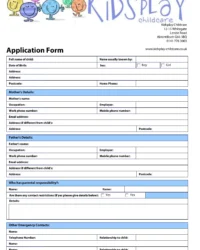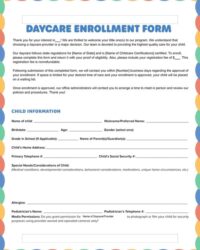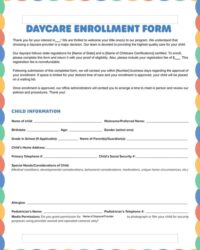Utilizing such a structured format provides several key advantages. It ensures that all necessary information is collected from each applicant, simplifying the comparison process and reducing bias. This consistency also contributes to a more professional image for the childcare provider. For applicants, a well-designed form provides clear guidance on what information is required, streamlining the application process and minimizing potential confusion or omissions. Ultimately, the standardized format helps childcare providers make informed hiring decisions that prioritize the safety and well-being of the children in their care.
The subsequent sections will delve deeper into the specific components of effective forms, offering practical guidance for both applicants seeking employment and childcare providers looking to optimize their hiring processes. Topics covered will include best practices for crafting compelling application materials, legal considerations, and strategies for evaluating applicant qualifications effectively.
Key Components of a Child Care Employment Application
Effective applications for child care positions require specific information to ensure the safety and well-being of children. The following components are typically considered essential:
1. Personal Information: This section gathers basic identifying information, including full legal name, contact details, and address. It establishes a clear point of contact for communication throughout the hiring process.
2. Educational Background: Details regarding relevant education, including high school diplomas, degrees, certifications in early childhood education, or related fields are crucial for assessing qualifications. Information about specific coursework related to child development, special needs education, or child psychology can further strengthen an application.
3. Professional Experience: Prior experience working with children, including specific roles, responsibilities, and duration of employment, provides valuable insight into an applicant’s practical skills and experience. Details regarding the age groups previously worked with, the size of the childcare setting, and the types of programs implemented are particularly relevant.
4. References: Contact information for professional references who can attest to an applicant’s character, skills, and experience working with children is essential for verifying information and gaining additional perspectives.
5. Background Checks and Clearances: Information regarding background checks and necessary clearances (e.g., criminal record checks, vulnerable sector checks) demonstrates a commitment to safety and compliance with legal requirements.
6. Certifications and Licenses (if applicable): Depending on the jurisdiction and specific role, certain certifications or licenses, such as First Aid/CPR certification or specific childcare licenses, may be required or preferred. Providing this information upfront streamlines the hiring process.
7. Availability and Schedule Preferences: Information about an applicant’s availability, including days of the week and preferred working hours, allows childcare providers to assess scheduling compatibility and staffing needs.
8. Statement of Purpose/Cover Letter (often included): While not always part of the application form itself, a statement of purpose or cover letter allows applicants to express their passion for working with children, highlight relevant skills and experiences, and explain their interest in the specific position or childcare setting.
Thorough documentation of these elements facilitates informed decision-making, leading to the selection of qualified and suitable individuals for child care roles. This comprehensive approach ultimately contributes to a safer and more nurturing environment for children.
How to Create a Child Care Employment Application Template
Creating a comprehensive and effective application template is crucial for attracting and selecting qualified candidates in child care. A well-designed template ensures consistency, efficiency, and legal compliance throughout the hiring process.
1. Define Essential Information: Determine the specific information required from applicants. This typically includes personal details, educational background, professional experience, references, and relevant certifications or licenses. Consider legal requirements for background checks and clearances within the specific jurisdiction.
2. Structure the Template: Organize the template logically into clear sections with concise headings and subheadings. Use a consistent format for questions and input fields to ensure readability and ease of completion.
3. Craft Clear and Concise Questions: Formulate questions that elicit specific and relevant information. Avoid ambiguous phrasing or leading questions that could introduce bias into the application process. Ensure questions comply with relevant employment laws and regulations.
4. Incorporate Consent Clauses: Include clear and explicit consent clauses for background checks, reference checks, and the handling of personal information in accordance with data privacy regulations.
5. Design for Accessibility: Ensure the template is accessible to all applicants, including those with disabilities. Consider font size, color contrast, and compatibility with assistive technologies.
6. Pilot Test the Template: Before implementing the template, conduct a pilot test with a small group to identify any areas for improvement in clarity, flow, or completeness.
7. Review and Update Regularly: Regularly review and update the template to reflect changes in legal requirements, best practices, and organizational needs. This ensures the template remains relevant and effective in attracting qualified candidates.
A robust application template streamlines the applicant screening process, enabling informed hiring decisions based on consistent and relevant information. This methodical approach promotes fairness, efficiency, and ultimately, the selection of individuals best suited to provide quality care for children.
Effective recruitment in the child care sector hinges on utilizing well-designed application materials. Standardized forms facilitate consistent information gathering, enabling childcare providers to efficiently assess applicant qualifications, experience, and suitability for specific roles. By adhering to best practices in template design, including clear questions, relevant sections, and legally sound consent clauses, organizations can streamline their hiring processes and ensure compliance with regulations. Comprehensive applications provide valuable insights into an individual’s preparedness for working with children, covering crucial areas such as educational background, professional history, and relevant certifications.
Prioritizing the development and implementation of robust application processes contributes significantly to enhanced safety and quality within child care settings. Diligent screening practices, supported by comprehensive application templates, ultimately benefit the children entrusted to these organizations by fostering environments where their well-being and development thrive. Continuous improvement of these processes remains essential for maintaining high standards and adapting to evolving needs within the field.


